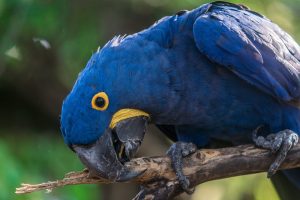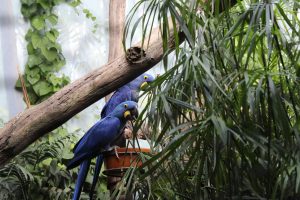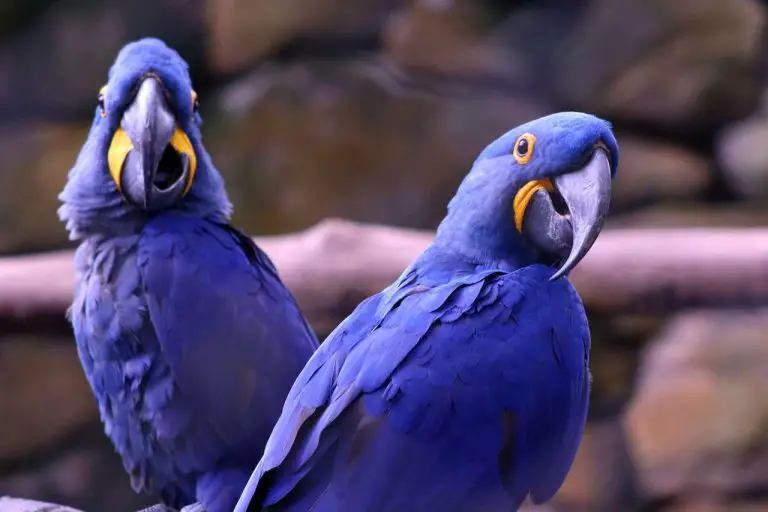The purple hyacinth macaw (Anodorhynchus hyacinthinus) is an astonishing-looking parrot. It is popular for its beautiful feathers and cobalt blue-like colors. When measured, it can reach a height of over one meter. It is also considered the largest type of flying parrot in existence.
The purple hyacinth macaw is classified as an endangered species. It is roughly calculated that the number of hyacinth macaws that continue to exist in the wild is around 2,500 to 3,000. This is a result of the large amount of illegal poaching being carried out in the forests housing them. They are mostly hunted for their feathers, as food, and for the pet trade.
In this post, we will be discussing all you need to know about the purple hyacinth macaw.
A brief history of purple hyacinth macaw

The purple hyacinth macaw, just like the other macaws, is mostly found living in the scrubland part of most rainforests. They love living in areas with light forests (few trees) and also grasslands.
Macaws are the biggest species of parrots. Out of over 376 species of parrots all over the world, macaws are considered the largest of them all. The purple hyacinth macaw can grow to a height of 3.5 feet and 4 to 5 feet in width when its wings are spread.
The Hyacinth Macaw loves to feed on seeds, nuts, fruits, flowers, and leaves. They possess strong beaks which they use to crack open nutshells. Hyacinth Macaws are blessed with immunity against certain poisons found in some of the foods they eat, such as the seeds of Hura crepitans.
Also, hyacinth macaws are incredibly loud and can be heard all around the jungle. They use loud noises to mark territory, identify partners, and also for entertainment. Also, they can imitate and copy sounds they hear, such as human speech. Trained hyacinth macaws can mimic and match different sounds and accents.
Hyacinth macaws are also long-lived animals. On average, hyacinth macaws can live up to sixty years in the open wild. Hyacinth macaws kept as pets can live up to 100 years and most times outlive their owners.
Origin of purple hyacinth macaw
The Hyacinth macaw is native to central-south America. It is also found in the eastern parts as well. They have three main natural habitats. These are the Cerrado (an equatorial savanna ecoregion of Brazil), the Pantanal ( which includes a natural territory of Brazil, the Plurinational State of Bolivia, and the landlocked country Paraguay), and the Amazon Drainage Basin of Brazil.
Hyacinth macaws live in low-lying areas like palm swamps, forests, and other half-open woody areas. They also prefer savannah pasture, barren thorn forests, and deep damp forests.
The Purple Hyacinth Macaw is to some extent part of the Psittacidae family of parrots. Just like other members of this family, the hyacinth macaws are mostly found in subtropical and tropical zones.
Also, the hyacinth macaw belongs to the genus Anodorhynchus. Anodorhynchus is made up of large blue birds, mostly from the eastern and southern parts of South America. Other birds found in this genus include the Lear’s macaw, also called the indigo macaw, and the glaucous macaw, which is now extinct. The hyacinth macaw loves nesting on trees (tree nesters ), while Lear’s macaws are cliff nesters.
The physical appearance of the purple hyacinth macaw
When it comes to physical appearance, the male and female hyacinth macaws are identical. They share very similar physical properties. There is no easy, reliable, or less invasive way to physically determine the sex of a hyacinth macaw. DNA testing and surgical sexing are the other means through which their gender can be determined.
There are some unreliable methods one can use to determine Hyacinth macaw sex. It is believed that female hyacinth macaws are more slender compared to their male counterparts. Another way of checking is through the shape of their beak. Female hyacinth macaws are said to have narrower beaks.
The hyacinth macaw is the tallest species of parrot in existence. They have beautiful violet-blue-colored feathers covering their entire bodies. The undersides of their feathers are black. Their brightly colored feathers stand out in their habitat and among other colored birds.
They also produce a special oily gland at the end of their tail. This gland is applied to the feathers for insulation and grooming purposes.
Their facial features vary in shape and size. Their eyes are covered by a bright yellow ring. They have limited eye movement, so they turn their heads and necks to change their view. They have a black iris which has a yellow band around it.
They have curved and powerful beaks capable of cracking different types of nuts, including coconuts and Brazil nuts. The base of their beaks is lined with a bright yellow color. The tip is hooked and hinged. This aids them in cracking nuts and tearing fruits. They have prehensile tongues that are dry and scaly. It has a bone in it that also aids in cracking and eating nuts.
Adult hyacinth macaws can reach a height of 39 inches or above when measured from the top of their heads to their toes. When hyacinth macaws spread their wings wide apart, the wingspan or spread can measure more than 4 feet.
The Hyacinth macaw is also the heaviest flying bird, with an adult weighing between 3 and 3.7 pounds.
Their toes are strong and agile, making them useful for grabbing things. Their first and fourth toes face backward, while their second and third face forward. This is called the zygodactyl pattern, and it is common among birds that are climbers.
Also, hyacinth macaws, despite their size, are decent fast-flying birds as they can hit 60km/hr in the air.
Why are hyacinth macaws called purple?
Do purple hyacinth macaws exist? This has been causing lots of confusion among bird enthusiasts. It is not scientifically proven or agreed upon that purple-colored hyacinth macaws exist. It has not been seen or documented to have ever existed.
Hyacinth macaws have a natural cobalt blue color. They are called purple hyacinth macaws because of the color difference when viewed under different light settings.
The color of the hyacinth macaw looks like a mixture of dark blue and violet. When viewed under bright light, the hyacinth macaw tends to have a lighter shade of purple.
Where can you get purple hyacinth macaw?
Purple hyacinth macaws are very rare and expensive to acquire. There are several ways you can acquire your purple hyacinth macaw without having to go catch them yourself in the wild.
You can obtain the hyacinth macaw from friends, family members, colleagues, and other acquaintances. These are people who may already have them and are willing to let go. Hyacinth macaws can be inherited from parents or be received as gifts from friends.
Also, taking proper care of hyacinth macaws can be very expensive, and not everyone can continue caring for them. If you know such people and you have the resources, you can offer to take care of their bird for them. If you are lucky, they might oblige.
Another way you can acquire the hyacinth macaw is by adopting it from a bird rescue home. It will be rare to see a hyacinth macaw being placed for adoption, but if you are patient enough, you might just be lucky.
Hyacinth macaws are long-lived birds that most often outlive their masters or owners. In situations like this, they mostly end up in rescue homes.
Finally, you can also get them from breeders. Acquiring hyacinth macaws this way can be costly and also risky. Ask questions and do your research before buying any hyacinth macaw to prevent unwanted stories.
How much does purple hyacinth macaw cost?

The price of hyacinth macaw is influenced by several factors. The number one factor is the fact that it is a rare bird. Hyacinth macaws are an endangered species with only around 2500 to 5000 of them remaining.
Another determining factor is the age of the bird. Younger hyacinth macaws are more accessible when compared to adult ones. Matured and trained hyacinth macaws even cost more because it takes a lot of time, effort, patience, and even resources to train them.
You can get hyacinth macaws from breeders within a price range of $5,000 to $12,000. Do not buy from those offering these birds at ridiculously cheaper prices. They are most likely scammers.
Are hyacinth macaws dangerous?
Hyacinth macaws can be dangerous. Hyacinth macaws, just like every other macaw, are not like other domestic animals. They are the largest flying parrots and, due to their size, can be dangerous. They have sharp talons which can easily be used to scratch and injure humans. They can also bite, and produce a bite force of around 400 PSI.
Now, not all hyacinth macaws are violent. Some are mild and meek, while others have quite a temper.
The behavior of a hyacinth macaw will be largely determined by its upbringing and training. Properly trained hyacinth macaws grow up to be friendly with a sensitive nature.
Benefits of having a purple hyacinth macaw
Keeping a pet bird such as the hyacinth macaw has a lot of benefits. Hyacinth macaws are gentle, loving birds that can help brighten your day and lift your spirit.
- Companionship
One of the benefits of having a purple hyacinth macaw is the companionship it provides. Just like every other pet, hyacinth macaws are great companions. With them around, it will be impossible for your home to be lonely. And with their ability to outlive their owners, having a hyacinth macaw means having a life companion.
- Social interaction
Hyacinth macaws are intelligent and social animals. They can mimic human speech, and if trained properly, can mimic an accent too. A good way to use this is by training your hyacinth macaw to greet you or others every morning. While training them, you also get to spend more time interacting with them.
- Reduce stress
Hyacinth macaws are playful birds that live to sing. Discussing with your pet bird can help reduce stress and anxiety. Parrots are great listeners and, at the same time, great communicators. Just ensure you don’t tell them any secrets, as they might spill bits of your secret to the next person who cares to listen.
FAQs
Are purple hyacinth macaws extinct?
The purple hyacinth macaws are very rare but not extinct. They are an endangered species and declared vulnerable (their population is decreasing). This is caused by the continuous encroachment of their natural habitat. They are also being hunted for food and headdress decorations, and to be used for the pet trade.
Does the purple hyacinth macaw bite?
Yes. Hyacinth macaw bites. They have very strong and durable beaks. Their beaks are curved and capable of cracking most nuts, such as coconut.
Their beaks are capable of not only biting but can break off the fingers of humans. But with proper training, hyacinth macaws can be trained not to bite humans.
How rare is a hyacinth macaw?

Hyacinth macaws are very rare. There are only about 2500 to 5000 of them left in their natural habitat. Also, acquiring the hyacinth macaw from breeders is very expensive, with one bird selling for around $5,000 to $12,000.
Can you own a hyacinth macaw in the US?
Yes. You can own a hyacinth macaw in the United States. You can buy and sell hyacinth macaws born in captivity. It is illegal in the United States of America to sell hyacinth macaws caught in the wild. So the legal way of acquiring a hyacinth macaw is by buying from verified breeders.
Conclusion
There is no bird scientifically recognized as the purple hyacinth macaw. The purple hyacinth macaw is mostly mistaken or interchanged for the hyacinth macaw. The reason for this is that the blue and violet colors of the hyacinth macaw are often mistaken for purple when viewed in a bright environment.
Hyacinth macaws are large birds that can reach a height of one meter. They are great pets, but they should undergo training first. The environment in which a hyacinth macaw is grown can affect its behavior. Those grown in hostile environments tend to be aggressive. While those grown in a good environment are more social and friendly.
More Read:

Hi, I’m Regina Rios. Just another bird lover who loves to share knowledge from personal experience. I’ve grown up with pet birds since childhood as my mommy also loves birds. As I can’t pet many birds in open air in my house as my mom does; I created my first bird cage on my rooftop using wood, copper wire, and a metal shed in 2018 and start collecting pet birds. Now, I have so many pet birds such as Macaws, Parrot, Cockatiel, Parakeet, and others. Not only that, if I see natural birds are injured I keep them in my house until they get well. Now, my hobby becomes my income source as my home birds have babies and I sell them to birds lover like mine. I’ve created this blog to inspire others bird owners by sharing my personal knowledge. Good Luck!


